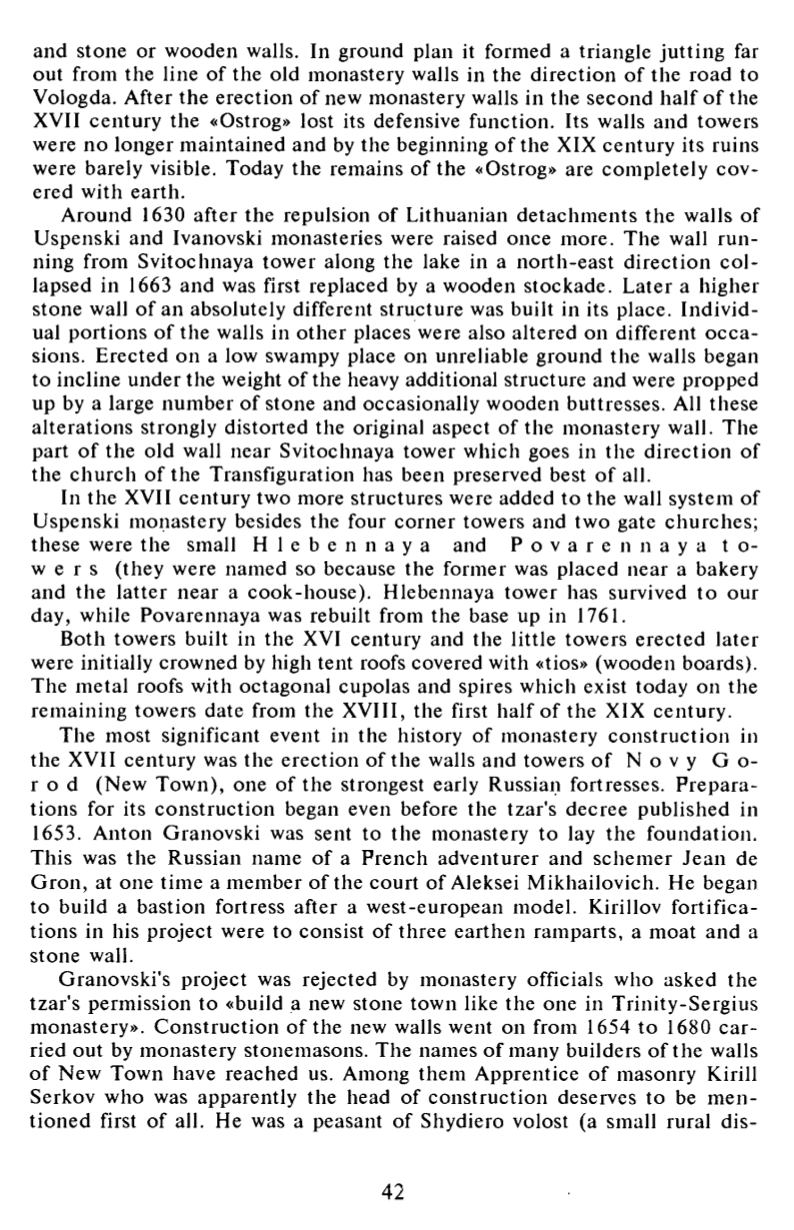

and stone or wooden walls. In ground plan it formed a triangle ju tting far
out from the line of the old monastery walls in the direction o f the road to
Vologda. After the erection of new monastery walls in the second ha lf o f the
XVII cen tury the «Ostrog» lost its defensive function. Its walls and towers
were no longer maintained and by the beginning o f the XIX cen tury its ruins
were barely visible. Today the remains of the «Ostrog» are completely cov
ered with earth.
Around 1630 after the repulsion of Lithuanian de tachmen ts the walls of
Uspenski and Ivanovski monasteries were raised once more. The wall r un
ning from Svitochnaya tower along the lake in a no rth-east d irec tion co l
lapsed in 1663 and was first replaced by a wooden stockade. Later a higher
stone wall o f an absolutely different structure was built in its place. Ind iv id
ual portions o f the walls in o ther places were also altered on different o c c a
sions. Erected on a low swampy place on unreliable ground the walls began
to incline under the weight of the heavy additional structure and were propped
up by a large number o f stone and occasionally wooden buttresses. All these
alterations strongly distorted the original aspect of the monastery wall. The
part o f the old wall near Svitochnaya tower which goes in the d irec tion of
the chu rch o f the Transfiguration has been preserved best o f all.
In the XVII century two more structures were added to the wall system of
Uspenski monastery besides the four corner towers and two gate churches;
these were the small H l e b e n n a y a and P o v a r e n n a y a t o
w e r s (they were named so because the former was placed near a bakery
and the latter near a cook-house). Hlebennaya tower has survived to our
day, while Povarennaya was rebuilt from the base up in 1761.
Both towers built in the XVI century and the little towers erected later
were initially crowned by high tent roofs covered with «tios» (wooden boards).
The metal roofs with octagonal cupolas and spires which exist today on the
remaining towers date from the XVIII, the first half o f the XIX century.
The most significant event in the history of monastery construc tion in
the XVII century was the erection of the walls and towers o f N о v у G o-
r о d (New Town), one of the strongest early Russian fortresses. P repa ra
tions for its construction began even before the tzar's decree published in
1653. Anton Granovski was sent to the monastery to lay the foundation.
This was the Russian name o f a French adventurer and schemer Jean de
Gron , at one time a member o f the court of Aleksei Mikhailovich. He began
to build a bastion fortress after a west-european model. Kirillov fortifica
tions in his project were to consist of three earthen ramparts, a moat and a
stone wall.
Granovski's project was rejected by monastery officials who asked the
tzar's permission to «build a new stone town like the one in Trinity-Sergius
monastery». Construction o f the new walls went on from 1654 to 1680 c a r
ried out by monastery stonemasons. The names o f many builders o f the walls
o f New Town have reached us. Among them Apprentice o f masonry Kirill
Serkov who was apparently the head of construction deserves to be m e n
tioned first of all. He was a peasant of Shydiero volost (a small rural d is
42















